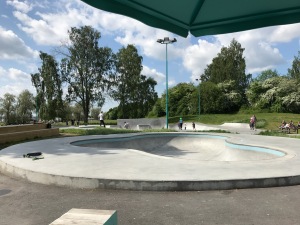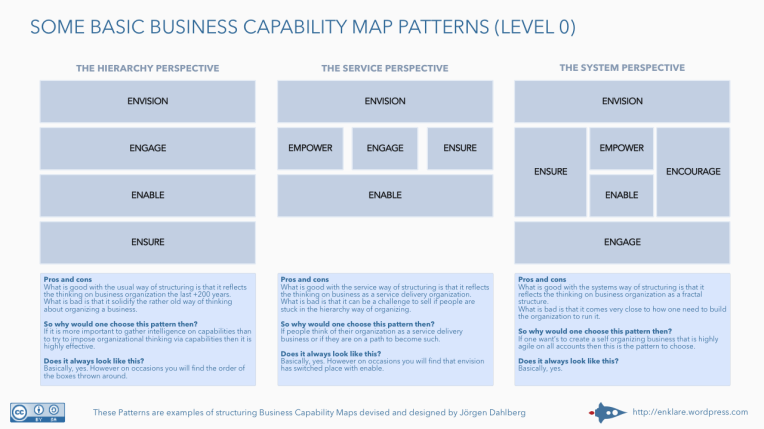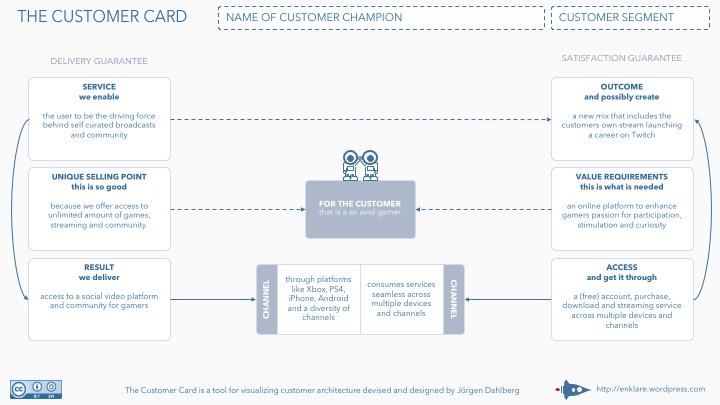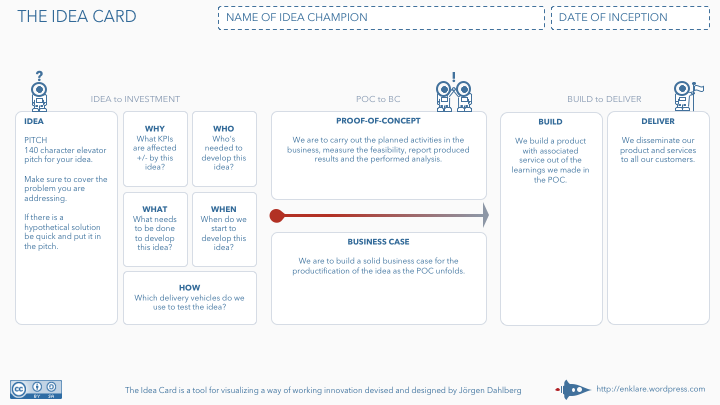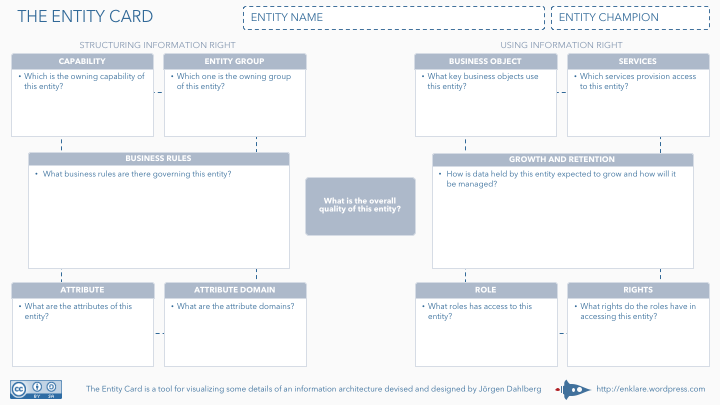I’ve had this outline of a book project laying dormant on Google drive for a couple of years. The working title was “The Art of Documenting Enterprise Architecture”. I’m not to fond of that title since I wasn’t aiming to document an architecture, rather capture and think through questions one would need answered to get insight into what the enterprise is all about.
There is no guarantee that I’m ever going to finish this post but the thing written a couple of years ago is still valid so I thought I’d publish that part here.
Enterprise Architecture Inquiry
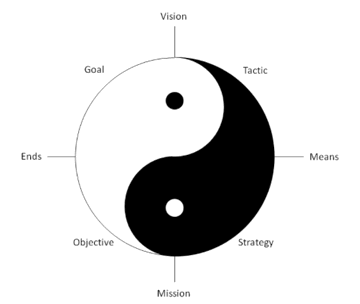
Many misread the depiction of the integrated view above. People ask – why is strategy closer to mission than vision? Why is tactic above strategy? To clarify this predicament it should be clear that the order one should read the integrated view above is starting with vision and then ends and then mission and lastly means. That closes the outer iteration and gives guidance to reading the inner iteration which start with goal and then objective and then strategy and lastly tactic.
Table of contents
Section 0 – The Things We Ought To Think About Before We Do Anything Else
Section 1 – The Historic Facts of the Enterprise
Section 2 – The Strategies
Section 3 – The Capabilities
Section 4 – The Business models
Section 5 – The Value flows
Section 6 – The People organisations
Section 7 – The Tactic plans
Section 8 – The Economic models
Section 9 – The Information
Section 10 – The Technologies
Section 11 – The Governance structures
Section 0 – The Things We Ought To Think About Before We Do Anything Else
The world is complicated, it may even be downright complex sometimes. We all know this, but what we don’t always recognise is that we don’t need to bring that into the formulation of the basic questions we seek to answer.
To keep it simple, here is five basic questions:
- Are we the right people doing the things we do?
- Are we doing the right things?
- Are we doing the right things well?
- Are we receiving the expected yield?
- Are we happy doing the things we do?
Section 1 – The Historic Facts of the Enterprise
The first of many small steps is usually the hardest to take. The second of a thousand steps is barely noticeable. The third of a million steps is forgotten. The last step of any walk determines if you will reach the target, yet the last step is rarely remembered. Any journey started must have an end; it cannot be that we journey without end. Time is the only resource with a direction and it points ever forward. We can only travel through time using our memory as the machine that displays the wonders that has happened before hand. Yet even if we may be at arm’s length in our minds we can still not change that which has happened, best then to plan for the future that has already happened.
Enterprise history
The purpose of these questions is to gather and structure data into what has happened. That data could be used in a diagnosis phase to gain insight into what could possibly be expected in the future from the Enterprise.
Culture
What values lie behind the way the Enterprise operate and to what extent are these values visible on a daily basis?
What cultures are active in the Enterprise today?
What core principles are there?
What behaviours are rewarded in the Enterprise?
How have these cultural components shifted over time?
Owners
Who has owned parts of the Enterprise and to what extent?
Why did they own parts of the Enterprise?
How has the ownership changed during the years and when did that happen?
Events
What events has affected the Enterprise and to what extent?
Why did they affect the Enterprise and how have they changed the Enterprise?
Markets
What markets has been targeted by the Enterprise and what was the outcome?
What was the investment made in those markets?
What was the purpose behind targeting those markets?
What offers/products/services where made to those markets?
What markets has been considered but then not entered into?
Products and services
What have been offered to the markets in terms of products and services?
What was the purpose behind this particular selection and what was the outcome?
Is there products or services created that where later decided against putting on the market and what was the reason behind that decision?
Immaterial
What immaterial rights (IR) have the enterprise held and what IR do they hold today?
What was the purpose behind this particular selection and what was the outcome?
What is the direction on IR today?
Location
What locations have the enterprise operated at?
Where is the enterprise operating today?
What was the purpose behind this particular selection and what was the outcome?
Permits and regulations
Under what permits and regulations have the enterprise operated?
What permits and regulations are in play today?
What was the purpose behind these particular selections and what was be the outcome?
Insurance
What insurances have the enterprise opted for?
What was the purpose behind this particular selection and what was the outcome?
Disputes
What disputes have the enterprise been involved in?
What was the reason behind this particular dispute and what was the outcome?
Agreements
What agreements have been entered into by the enterprise?
Why where they so important and what was the outcome?
Customers
What has been the most important customer segment?
Why where they so important?
What was the outcome for those customer segment?
What customer segments is in play today?
Partners / Suppliers
Who has been the most important partners / suppliers?
Why where they so important?
What was the outcome from those relationships?
Competition
Who have been the most important competitors?
Why where they so important?
What was done to win over them and what was the outcome?
Employees
How many employees have there been over time?
What key skills did they possess?
What was the purpose of having those employees and what has been the outcome so far?
Management
How many managers and managerial roles have there been over time?
What was the purpose of having those managers/roles and what has been the outcome so far?
Board
How many board members have there been?
Who where these board members?
What was the purpose of electing those board members and what has been the outcome so far?
Economic
How has the profit and loss evolved over time?
What was it that effected the P/L to develop like it did?
What revenue streams have the Enterprise had?
Section 2 – The Strategies of the Enterprise
Many of us have spoken of strategy and tactics and even more have listened to the words being uttered as a vision for some important change. Few have given thought to the true meaning of the words and even fewer have tried to alter their use of the words. It should be clear that in this post I refer to a strategy as a description of a way forward, it contains the general characteristics of the path we would like to travel if all unfolds according to plan. A tactic on the other hand is a detailed recollection of the actions and events that follow the course of a strategy.
Strategic concepts
The purpose is to find the questions that would capture the strategy as concepts used in the enterprise.
To be written…
Tactical concepts
The purpose is to find the questions that would capture the tactic as concepts used in the enterprise.
To be written…
Section 3 – The Capabilities of the Enterprise
There seems to be as many ways of talking about capabilities as there are ways of putting a shoe together. To add to the confusion functions, processes and other concepts of enterprise architecture is widely used as capabilities. Here we refer to capabilities as the core skills that we must master as a social system (the organisational level).
To be written…
Section 4 – The Business models
To be written…
Section 5 – The Value flows
To be written…
Section 6 – The People organisations
To be written…
Section 7 – The Tactic plans
To be written…
Section 8 – The Economic models
To be written…
Section 9 – The Information
In asking questions about the information we need to look both where we are and where we could be.
What common terms & definitions?
What enterprise information architecture?
What meta data and master data?
Which data management tools?
What data governance structures?
Section 10 – The Technologies
In asking questions about the technologies we need to look both where we are and where we could be.
Which technology stack?
Which applications?
Where use custom development, standard applications, utility services?
Which communication (Integration, Service Orientation…)?
What roadmaps?
Which guiding principles?
Section 11 – The Governance structures
To be written…
Post change log
2015-10-27: Published initial post
2015-11-07: Added some questions on technologies and information
